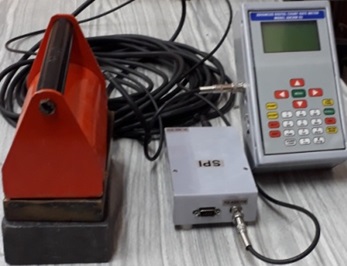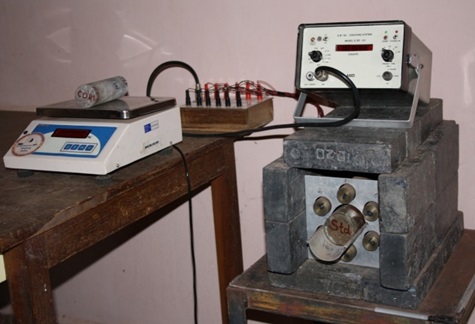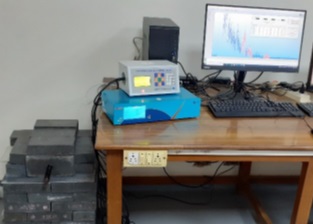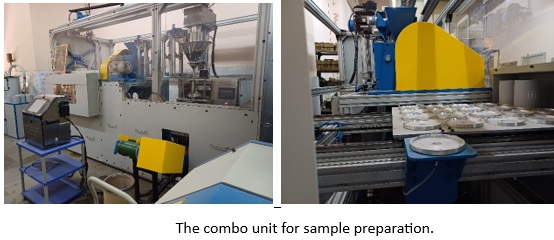|
Physics laboratories located at the seven Regional Centres of AMD i.e. Northern Region, New Delhi; Southern Region, Bengaluru; Eastern Region, Jamshedpur; North Eastern Region, Shillong; Western Region, Jaipur; Central Region, Nagpur and
SouthCentral Region, Hyderabad along with Radiation Standards and Analytical (RSA) Laboratory at HQ, Hyderabad constitute Physics Group.
Physics Laboratories provide analytical support to the exploration activities of the department and carry out gamma-ray logging of boreholes, shielded probe logging of the trenches/outcrops and radiometric analyses of rock, soil and core
samples. Physics laboratory, Central Region, Nagpur is also involved in calibration of gamma-ray spectrometers (airborne/portable/ground/jeep/car-borne) for radiometric survey at fixed calibration pads at Civil Airport, Nagpur and
portable calibration pads at heliborne survey base station. In addition, Physics laboratories at Northern Region, New Delhi; Southern Region, Bengaluru; Western Region, Jaipur; North Eastern Region, Shillong and Central Region, Nagpur
are also designated as DAEs Emergency Response Centres (ERC) for nuclear/ radiological emergencies.
Primary assignments of Regional Physics Laboratories
|
Gamma-ray logging is the technique used to know the subsurface concentration and thickness of the mineralisation. %eU3O8 (equivalent uranium oxide) is determined in the range from ppm to percent
level using either a GM detector or a scintillation detector.
|

|
|
This technique is used to know the surface extent of the mineralisation in outcrops / trenches by determining the equivalent uranium oxide concentration using GM detector.
|

|
|
Six GM tubes in circular geometry are used to measure the eU3O8 concentration of borehole core samples.
|

|
|
Radiometric analysis assemblies based on NaI(Tl) detector or HPGe detectors are installed in all the laboratories to determine radionuclide concentration in geological samples.
4.1: eU3O8 analysis: Total gamma activity of the sample is measured for eU3O8 content using an integral assembly (NaI(Tl) scintillation detector) to delineate
the active samples for further analysis.
4.2: Gamma-ray spectrometry using NaI(Tl) detector: The radium(Ra(eU3O8)), thorium (ThO2) and potassium (%K) contents of rock samples are determined by measuring the
characteristic high energy gamma rays emitted by these radionuclides and/or their daughter products using DSP based gamma-ray spectrometry system coupled to NaI(Tl) detector.
|
|
4.3: High resolution gamma ray spectrometry using HPGe detector:: The radium (Ra(eU3O8)), thorium (ThO2) and potassium (%K) concentration along with the uranium content
(U3O8) of geological samples are determined by measuring the characteristic gamma rays emitted by these radionuclides and/or their daughter products using High Purity Germanium detector. The
uranium content in the geological samples is determined using gamma rays of 234Th and 234mPa.
|

|
|
4.4: U3O8 analysis by beta-gamma method: The estimation of uranium in geological samples is also carried out by simultaneous measurement of beta and gamma radiations. The PC based five channel counting
system developed and fabricated in-house, consists of a NaI(Tl) crystal for gamma measurement and pancake type beta tubes for total beta counting.
|

Measurement of U3O8 and Ra(eU3O8) content of rock samples help in understanding the uranium series disequilibrium in different uranium rich areas.
|
|
4.5. Monazite equivalent determination: Beach Sand Minerals (BSM) export consignment samples are assayed for equivalent Monazite and ThO2 content using NaI(Tl) detectors.
|
Physics group also carries out research and development in the field of radon measurements in water, soil and ambient air. The radon lab has optimised the use of radon measurement equipment RAD-7 for use in uranium exploration and
environment measurements.
|
A temperature logging probe fabricated in-house by Physics Laboratory, ER is being used in the Helium Investigation.
|

|
Gamma ray logging is based on measurement of gamma radiations emitted by Uranium decay daughters and it is indirect measurement of Uranium. It will not give the correct grade of ore body if it is in disequilibrium. Prompt Fission Neutron
(PFN) logging over comes this problem. It is used for estimation of uranium mineralization directly in a borehole by measuring the U235 in the formation through prompt fission neutron measurement. It is relatively complex system
and expensive. PFN logging system is in developmental stage in collaboration with BARC.
|
All the Physics laboratories are equipped with jaw crushers, ring grinders and mixers for preparation of representative samples of different mesh sizes. RSA laboratory at Hyderabad has recently installed a combo unit
to grind 20 samples to required mesh size in one loading.
|

|
|